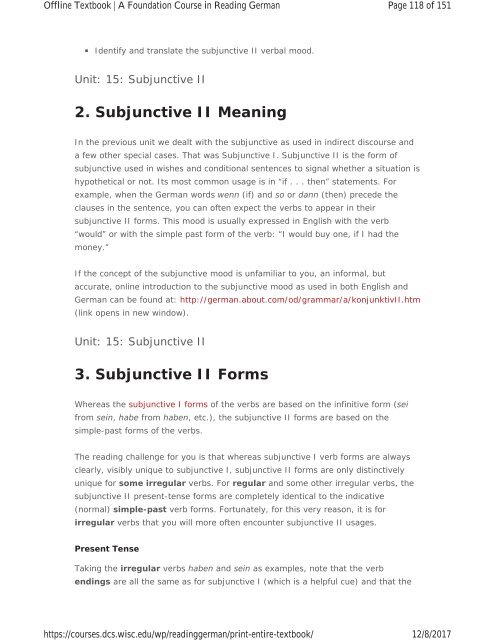A Foundation Course in Reading German, 2017a
A Foundation Course in Reading German, 2017a
A Foundation Course in Reading German, 2017a
You also want an ePaper? Increase the reach of your titles
YUMPU automatically turns print PDFs into web optimized ePapers that Google loves.
Offl<strong>in</strong>e Textbook | A <strong>Foundation</strong> <strong>Course</strong> <strong>in</strong> Read<strong>in</strong>g <strong>German</strong><br />
https://courses.dcs.wisc.edu/wp/read<strong>in</strong>ggerman/pr<strong>in</strong>t-entire-textbook/<br />
Page 118 of 151<br />
12/8/2017<br />
Identify and translate the subjunctive II verbal mood.<br />
Unit: 15: Subjunctive II<br />
2. Subjunctive II Mean<strong>in</strong>g<br />
In the previous unit we dealt with the subjunctive as used <strong>in</strong> <strong>in</strong>direct discourse and<br />
a few other special cases. That was Subjunctive I. Subjunctive II is the form of<br />
subjunctive used <strong>in</strong> wishes and conditional sentences to signal whether a situation is<br />
hypothetical or not. Its most common usage is <strong>in</strong> “if . . . then” statements. For<br />
example, when the <strong>German</strong> words wenn (if) and so or dann (then) precede the<br />
clauses <strong>in</strong> the sentence, you can often expect the verbs to appear <strong>in</strong> their<br />
subjunctive II forms. This mood is usually expressed <strong>in</strong> English with the verb<br />
“would” or with the simple past form of the verb: “I would buy one, if I had the<br />
money.”<br />
If the concept of the subjunctive mood is unfamiliar to you, an <strong>in</strong>formal, but<br />
accurate, onl<strong>in</strong>e <strong>in</strong>troduction to the subjunctive mood as used <strong>in</strong> both English and<br />
<strong>German</strong> can be found at: http://german.about.com/od/grammar/a/konjunktivII.htm<br />
(l<strong>in</strong>k opens <strong>in</strong> new w<strong>in</strong>dow).<br />
Unit: 15: Subjunctive II<br />
3. Subjunctive II Forms<br />
Whereas the subjunctive I forms of the verbs are based on the <strong>in</strong>f<strong>in</strong>itive form (sei<br />
from se<strong>in</strong>, habe from haben, etc.), the subjunctive II forms are based on the<br />
simple-past forms of the verbs.<br />
The read<strong>in</strong>g challenge for you is that whereas subjunctive I verb forms are always<br />
clearly, visibly unique to subjunctive I, subjunctive II forms are only dist<strong>in</strong>ctively<br />
unique for some irregular verbs. For regular and some other irregular verbs, the<br />
subjunctive II present-tense forms are completely identical to the <strong>in</strong>dicative<br />
(normal) simple-past verb forms. Fortunately, for this very reason, it is for<br />
irregular verbs that you will more often encounter subjunctive II usages.<br />
Present Tense<br />
Tak<strong>in</strong>g the irregular verbs haben and se<strong>in</strong> as examples, note that the verb<br />
end<strong>in</strong>gs are all the same as for subjunctive I (which is a helpful cue) and that the


















